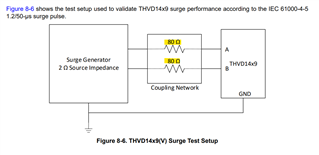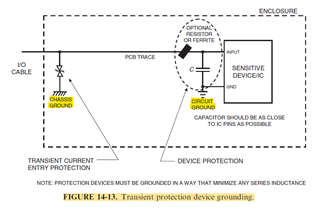Other Parts Discussed in Thread: THVD1400
Tool/software:
Hello E2E Community,
We seek your inputs & clarification on following queries in regards to the IEC 61000-4-5 Surge testing of the THVD1439
- Why is there a 80Ohm coupling network - what does this imply?
- The datasheet further suggests a layout - my question - is it okay to connect the TVS coupled ground pin to the digital ground on the PCB?
- Is dumping the surge transients current in the main circuit digital ground a good approach?
- Can I simply connect the THVD1439 ground to chassis ground which is at one point connected to the digital ground - thereby minimizing the surge transients on the digital ground?
We will also install a 15Ohm pulse rated series current limiting resistors on both A & B - with objective to further reinforce the surge transient robustness by reducing the current entering the transreceiver.



